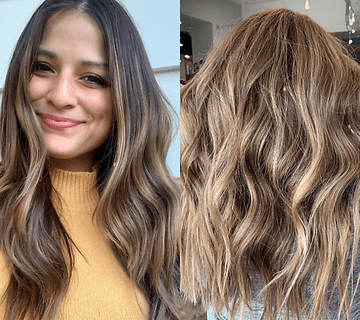There can be a bit of a language barrier at the hair salon, even if everyone is technically speaking the same language. It can be difficult for someone who speaks hair fluently to communicate with someone who only speaks it conversationally, and vice versa; and the last thing anyone wants is a mistranslation. Have no fear! We’ve compiled and translated a few key terms that can make or break communicating your vision to your stylist properly.
Cool Tones vs. Warm Tones
Speaking of make-or-break; this is a big one. These terms apply to almost any color you can describe; blondes, brunettes, reds, and even some fashion colors like “rose gold” can be described as cool, warm, or neutral toned. So, what’s the difference? Cool colors have violet or blue undertones, whereas warm colors have red or gold undertones; and neutral colors sit right in the middle of the spectrum. Oftentimes, a stylist can determine your preference based on the photos you bring in, however, there are times that clients bring in multiple images that conflict with one another; so it can be helpful to specify what exactly you like about each photo.

Cool Blonde vs Warm Blonde (Both By Karina Elbo)
Foilyage vs. Balayage
This one can be tricky because it describes the technique more than it does the finished look. If that’s the case, why is the distinction important? Well, in this case, it’s all about the money, baby. Generally speaking, foilayage is slightly pricier than balayage because it utilizes more materials and can provide a lighter result in one session than balayage. Ask your stylist to identify the technique that they think is necessary to achieve your desired look if you’re trying to be price-conscious.

Balayage (Left, by Mark Rodriguez) vs. Foilayage (Right, by Pray Soni)
Shadow Root vs. Natural Root
It seems that roots are as in as ever; so much so that several different styles of rooty colors have evolved from the trend. The thing is, some of these “roots” are actually hair that has been highlighted to the scalp (or very close to the scalp) and then toned with a darker color than the rest of the hair; thus creating a shadow that simulates depth and better blends the highlights. Again, root shadows tend to be an upcharge, so this is good to know for the savvy shopper.

Shadow Root (Left, by Bailey Watson) vs. Natural Rool (Right, by Monika Knotts)
Porosity
The concept is simple: the more chemical or heat damage your hair has endured, the more easily penetrable the outermost layer of the hair strand (the cuticle) will be. This means that not only is the hair fragile, but also that you will most likely deal with frizz, breakage, flyaways, and your hair may even be unable to handle toners or color if the cuticle is completely compromised. This is important to know because by understanding how porous your hair is after a chemical or color process, the proper steps can be taken, and proper products and treatments used, to maintain your hair’s integrity for the long-term.
Corrective Color
A color correction can be defined as any color process that creates an extreme change; i.e. going from very dark to light, or from very light to dark; or just from a botched hair color to a not botched one. These services often take several hours, and have several variants at play that are unpredictable to the stylist. It’s for these reasons that stylists often charge by the hour instead of by the services they’re performing. With this one, understanding that what you’re really paying for is the time it takes for your stylist to delicately decode your hair color to give you the result you’re seeking is key.

Before & After a Color Correction (By Chelsea Styrk)




